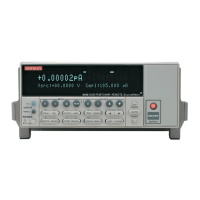Data Store 8-5
The timestamp is based on an oscillator with a frequency of approximately 8kHz. This oscil-
lator is used as the system clock and is divided by eight to generate system “ticks” every milli-
second. Therefore, the timestamp should provide lms resolution for test timing. However, since
the actual oscillator frequency is 8.192kHz, a system tick occurs every 8.192kHz/8 or 1024
times a second, which results in a system tick every 0.9765625ms. As a result, the reported
timestamp value is off by 24ms every second. Thus, to obtain more accurate timestamp values,
simply multiply the timestamp displayed on the front panel or returned via remote by a factor
of 0.9765625.
Buffer considerations
From the front panel, 2,500 source-measure readings can be stored and accessed using the
method described earlier in this section. Over the bus, however, there are actually two separate
2,500 reading buffers for a total of 5,000 readings. The :TRACe buffer is a 2,500 reading buffer
used by front panel data store, bus :TRACe commands, and to store sweep data, and it is bat-
tery backed-up. The READ? buffer is a separate 2,500 reading buffer that can only be accessed
over the bus using the :READ? command. You can store and access data from these two buffers
separately as outlined below.
Using :TRACe commands to store data
Use :TRAC:POIN <n> and :TRIG:COUN <n> followed by :TRAC:FEED:CONT NEXT to
store data. (n = number of readings; 2,500 maximum.) Turn on the output with :OUTP ON and
then send :INIT to take the unit out of idle and store readings. After data is stored, send
:TRAC:DATA? to access it. See Table 8-1 for a summary of these commands and :TRACe sub-
system in Section 17 for more details.
Using :READ? to store data
Use :TRIG:COUN <n> to set the number of readings to be stored. (n = number of readings;
2,500 maximum.) Turn on the output with :OUTP ON and then send the :READ? command to
trigger and access readings. (Once you access these readings, you will still be able to access
previously stored. :TRACe buffer readings using :TRAC:DATA?.) See Section 10 and Trigger
subsystem in Section 17 for triggering details, and Section 16 for information on the :READ?
command.

